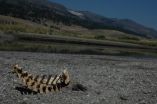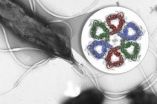(Press-News.org) Josh Miller likes to call himself a conservation paleobiologist. The label makes sense when he explains how he uses bones as up-to-last-season information on contemporary animal populations.
Bones, he says, provide baseline ecological data on animals complementary to aerial counts, adding a historical component to live observation. In his November cover article for the Ecological Society of America's journal Ecology, he assesses elk habitat use in Yellowstone National Park by their bones and antlers, testing his method against several decades of the Park Service's meticulous observations.
Now an assistant research professor in the new Quaternary and Anthropocene Research Group in the Department of Geology at the University of Cincinnati, Miller located and recorded the elk bone data while a doctoral student in paleontology at the University of Chicago, and finished analyzing the data during a brief stint at the Florida Museum of Natural History at the University of Florida, in Gainesville. His work with modern animals grew out of curiosity about the fidelity of the fossil record in archiving animals and ecosystems of the distant past.
"It turns out that bones are really informative," he said. At Yellowstone, bone and antler concentrations mirror patterns of animal landscape use known from years of aerial surveys. "This opened up a completely unexpected opportunity for studying modern ecosystems, particularly for areas where our knowledge of animal populations is more limited."
Reconstructing animal community structure and habitat use through the bones of past generations is a new idea. Until recently, common knowledge held that, on the landscape, bones just don't last that long. But Miller has found that they can last for hundreds of years. Bones weather in a stereotypical pattern, from fresh to falling apart. He calibrated weathering in the Yellowstone bones through radiocarbon dating, gaining a familiarity that would allow him to pick up a bone and know it had seen a year, 20 years, or 80 to 100 years or more on the open ground.
Bull elk shed their antlers in late winter, when forage is sparse. Too poor in nutrients to interest most scavengers, heavy, and awkwardly shaped for displacement by the elements, antlers tend to stay where they fall. Miller found that, for the most part, the bones of calves don't travel far either, even in the mouths of predators. The bones of calves mark the range where their mothers sought plentiful food to fuel months of nursing, and shelter to hide their vulnerable newborns.
Old bones from past decades outline a range consistent with the living herd. Miller saw only moderate shifts in a few areas, even given the many recent changes at Yellowstone: the prodigious wildfires of 1988, repatriation of grey wolves starting in 1995, and regrowth of willows, aspen, and cottonwoods over the last couple of decades following a long decline during the 20th century.
Because bones can last decades to centuries in the Yellowstone environment, Miller says they can put relatively recent data from direct observation into broader context for managers looking at long-range planning, helping to sort out important changes from the noise of cyclical booms, busts and shifts in landscape use. Bones are a minimally invasive tool for tracking the history of range animals. They are data just lying on the ground, waiting to be collected.
INFORMATION:
Spatial fidelity of skeletal remains: elk wintering and calving grounds revealed by bones on the Yellowstone landscape (2012) Joshua H. Miller. Ecology 93:11, 2474-2482.
Contact:
Joshua Miller
Department of Geology & the Quaternary and Anthropocene Research Group, University of Cincinnati.
http://homepages.uc.edu/~mille5ju/
josh.miller@uc.edu
(513) 556-6704
Journalists and public information officers can gain access to full texts of all ESA publications by contacting the public affairs office. Email Liza Lester, llester@esa.org.
The Ecological Society of America is the world's largest community of professional ecologists and a trusted source of ecological knowledge. ESA is committed to advancing the understanding of life on Earth. The 10,000 member Society publishes five journals, convenes an annual scientific conference, and broadly shares ecological information through policy and media outreach and education initiatives. Visit the ESA website at http://www.esa.org.
To subscribe to ESA press releases, contact Liza Lester at llester@esa.org.
Elk bones tell stories of life, death, and habitat use at Yellowstone National Park
2012-12-10
ELSE PRESS RELEASES FROM THIS DATE:
New multiple myeloma drug shows promise in treating people with advanced disease
2012-12-10
A new oral agent under review by the U.S. Food and Drug Administration (FDA) is safe and effective in treating relapsed and treatment-resistant multiple myeloma, according to a multicenter, Phase II study presented by Mount Sinai School of Medicine researchers at the American Society of Hematology (ASH) Annual Meeting. The meeting is taking place December 8-11, 2012 in Atlanta.
A multi-center research team evaluated 113 patients with multiple myeloma who had received at least two prior therapies and had subsequent disease progression to determine safety and efficacy of ...
Morning vs nighttime replacement affects adverse events with extended-wear contact lenses
2012-12-10
Philadelphia, Pa. (December 10, 2012) - For people using 30-day extended-wear/continuous-wear (EW/CW) contact lenses, replacing lenses at night doesn't lower the risk of complications compared to changing lenses monthly, suggests a study – "The Effect of Daily Lens Replacement During Overnight Wear on Ocular Adverse Events", appearing in the December issue of Optometry and Vision Science, official journal of the American Academy of Optometry. The journal is published by Lippincott Williams & Wilkins, a part ofWolters Kluwer Health.
In contrast, replacing lenses every ...
Face transplantation calls for 'reverse craniofacial planning'
2012-12-10
Philadelphia, Pa. (December 10, 2012) - As surgical teams gain experience with facial transplantation, a careful approach to planning based on the principles of craniofacial surgery can help to maximize patient outcomes in terms of facial form and function, according to an article in The Journal of Craniofacial Surgery. The journal, under the editorship of Mutaz B. Habal, MD, is published by Lippincott Williams & Wilkins, a part ofWolters Kluwer Health.
In patients with extensive facial defects including loss of the normal bone and soft tissue landmarks, a "reverse craniofacial ...
Survey shows breakthrough medical research relies heavily on NIH funding
2012-12-10
(ATLANTA, December 10, 2012) – A survey highlighting the correlation between today's cutting edge medical research and the National Institutes of Health (NIH) funding was released today at the 54th Annual Meeting of the American Society of Hematology (ASH), the preeminent medical meeting for physicians and scientists in hematology that draws more than 20,000 attendees from around the world. The survey, representing responses from 1,040 abstract presenters from the U.S. and abroad, demonstrates how critical NIH funding has been to the success of science and medicine.
"Every ...
The image of mental fatigue
2012-12-10
We all perhaps know the feeling of mental exhaustion, but what does it mean physiologically to have mental fatigue? A new study carried out using brain scans could help scientists uncover the neurobiological mechanisms underlying mental fatigue.
According to Bui Ha Duc and Xiaoping Li of the National University of Singapore writing in a forthcoming issue of the International Journal Computer Applications in Technology, mental fatigue has become commonplace as many people face increasing mental demands from stressful jobs, longer working hours with less time to relax and ...
Researchers demonstrate that a saliva analysis can reveal decision-making skills
2012-12-10
A study conducted by researchers at the University of Granada Group of Neuropsychology and Clinical Psychoneuroimmunology has demonstrated that cortisol levels in saliva are associated with a person's ability to make good decisions in stressful situations.
To perform this study, the researchers exposed the participants (all women) to a stressful situation by using sophisticated virtual reality technology. The study revealed that people who are not skilled in decision-making have lower baseline cortisol levels in saliva as compared to skilled people.
Cortisol –known ...
Experiment finds ulcer bug's Achilles' heel
2012-12-10
Experiments at the U.S. Department of Energy's (DOE) SLAC National Accelerator Laboratory have revealed a potential new way to attack common stomach bacteria that cause ulcers and significantly increase the odds of developing stomach cancer.
The breakthrough, made using powerful X-rays from SLAC's Stanford Synchrotron Radiation Lightsource (SSRL), was the culmination of five years of research into the bacterium Helicobacter pylori, which is so tough it can live in strong stomach acid. At least half the world's population carries H. pylori and hundreds of millions suffer ...
Frankincense is for life, not just for Christmas
2012-12-10
At this time of year it is hard to escape the Three Wise Men, riding their camels across Christmas cards and appearing in minature form in countless school nativity plays across the world, bearing their gifts for the infant Jesus. Whilst we are all familiar with gold (especialliy in this Olympic year), it is the mention of frankincense and myrrh that really says "Christmas" to us and and takes our imaginations back to ancient times. But you might be surprised to learn that these two fragrances are still big business today; for example, Ethiopia alone trades around 4000 ...
Oxytocin produces more engaged fathers and more responsive infants
2012-12-10
Philadelphia, PA, December 10, 2012 – A large body of research has focused on the ability of oxytocin to facilitate social bonding in both marital and parenting relationships in human females. A new laboratory study, led by Dr. Ruth Feldman from Bar-Ilan University in Israel and published in the current issue of Biological Psychiatry, has found that oxytocin administration to fathers increases their parental engagement, with parallel effects observed in their infants.
Oxytocin is a neuropeptide that plays an important role in the formation of attachment bonds. Studies ...
Onion soaks up heavy metal
2012-12-10
Onion and garlic waste from the food industry could be used to mop up hazardous heavy metals, including arsenic, cadmium, iron, lead, mercury and tin in contaminated materials, according to a research paper published in the International Journal of Environment and Pollution.
Biotechnologists Rahul Negi, Gouri Satpathy, Yogesh Tyagi and Rajinder Gupta of the GGS Indraprastha University in Delhi, India, explain how waste from the processing and canning of onion (Allium cepa L.) and garlic (Allium sativum L.) could be used as an alternative remediation material for removing ...

